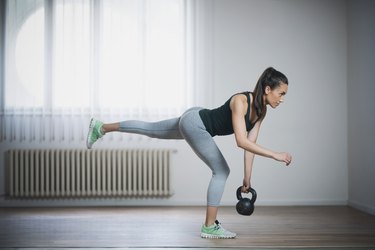
Lifting weights is an effective way for women to build lean muscle, lose weight, get stronger and improve endurance. For many, though, heading to a gym to lift weights isn't an option, either due to a busy schedule, work and family responsibilities or even a lack of confidence in the weight room.
The solution: Weight training at home, which is convenient and allows you to progress at a pace you feel comfortable at and in an environment where you feel confident. But how can you be sure if you're doing it right — and getting the most you can from your at-home weight workout?
Video of the Day
Video of the Day
Read more: 5 Workouts for Strength Training at Home
Step 1: Equip Your Home Gym
Set aside a dedicated space to complete your workouts — such as a spare bedroom, a corner of the basement or even your living room floor in front of the couch. Then make sure you have all the equipment you need. A few sets of dumbbells (at least one medium weight and one heavy) along with a mat, towel and water bottle.
Depending on your budget and preferences, you may want to invest in a few other pieces of at-home workout equipment, such as a kettlebell or two or a barbell with plates.
The size of the weights you have access to may dictate what type of routine you do. "If you only have small weights at home, try a high-intensity circuit to get the most out of the workout," says says Alysa Boan, a Dallas-based certified personal trainer at RealFitnessMaven.
"Utilize the weights as frequently as you can, focusing on compound movements such as squat to press." That way, you'll get the most bang from your buck in a short amount of time — and you'll increase your caloric burn while you strengthen and tone.
If you have heavier weights, you can focus on a more traditional weight-lifting sequence. For example, you could pick six exercises and perform three sets of eight to 10 reps of each exercise, resting in between sets and exercises.
Step 2: Set a Plan in Place
Getting into a consistent, predictable routine is one of the most important aspects of lifting weights at home. While gym goers have the ritual of getting ready, leaving their home or work and then entering the place where they train, you'll need to create this routine in a more intentional way.
Set aside specific time on specific days that you'll train, so that you stick to your plan. For example, you might train your upper body on Monday and Thursday at 10 a.m., and your lower body on Tuesday and Friday at 7 p.m. or another time that consistently suits your schedule.
The key is to commit to plan — but stay flexible, and not beat yourself up when you miss a workout.
Step 3: Prioritize Workout Intensity
"I always encourage my clients to focus on intensity of the workout, especially if they are short on time," say Boan. "That means moving from one exercise to the next with minimal rest."
That can mean circuit training (moving from one exercise to the next and repeating a given set of exercises), strength-focused HIIT (alternating high-intensity work with rest periods) or supersets and trisets (two or three exercises performed back to back with no rest in between).
Step 4: Target Your Upper Body
Train your upper body at least twice a week for the best results. Make sure you leave at least a full day between your upper-body workouts to allow your muscles time to rest and recover.
And there's no need to worry about getting bulky, masculine muscles — most women don't have the hormonal profile necessary for that. "As females, we generally don't have enough testosterone to achieve big bulky muscles," says Boan.
Focus on doing moderate rep ranges with weights that challenge you, and mix up your moves so that you target all the major upper-body muscles. Some examples include:
- Chest press
- Chest fly
- Bent-over row
- One-arm row
- Shoulder press
- Lateral raises
- Biceps curls
- Hammer curls
- Triceps extensions
- Triceps kickback
- Bent-over fly
- Skull crushers
Do three sets of eight to 12 repetitions for each move, taking water breaks throughout. A good rule of thumb: The weight you use for each exercise should allow you to complete at least eight reps, but not more than 12 per set. And the last two reps should be challenging but still doable with proper form.
Step 5: Don't Skimp on Lower-Body Workouts
Working your lower body should also happen twice a week. Your lower body produces a tremendous amount of force during weight-training sessions, and this can be very taxing on your musculoskeletal and central nervous systems. For this reason, be sure to have at least one rest day between sessions — or preferably two or even three.
Again, choose weights that will allow you to complete at least eight repetitions but no more than 12 in a set. Good exercises that'll work your quadriceps, hamstrings, and glutes include:
- Romanian deadlifts
- Split squats
- Single-leg deadlifts
- Goblet squats
- Sumo squats
- Walking lunges
- Reverse lunges
- Lateral lunges
- Single-leg squats
- Calf raises